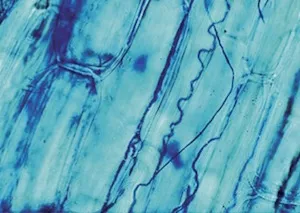
Nonsystemic fungal endophytes increase survival but reduce tolerance to simulated herbivory in subarctic Festuca rubra
Fungal endophytes – fungi that live within plant tissues (see photo) – are common in nature, but whether they are mutualists, parasites or living within plants as commensals is poorly understood. Former undergraduate student James Santangelo (Kotanen Lab) sought to disentangle the effects of endophytes on plants and the results of his study were just published in Ecoshpere in his article “Nonsystemic fungal endophytes increase survival but reduce tolerance to simulated herbivory in subarctic Festuca rubra”. James studied a group of endosymbionts infecting the leaves of red fescue, a widespread grass, to examine their role in altering their host’s ability to survive under saline soil conditions and frequent herbivore damage. Overall we found that endophytes increased survival under saline conditions but reduced their ability to withstand damage. This work suggests endophytes may serve more complex ecological roles than previously thought.
